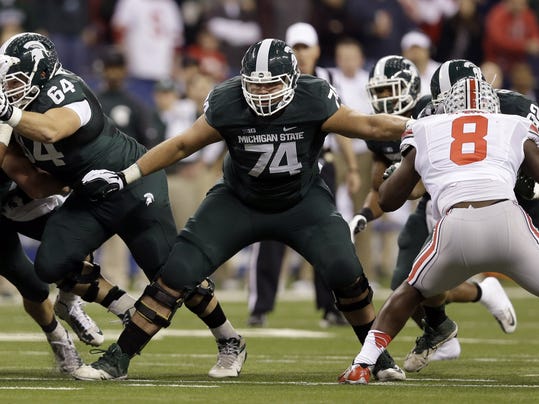Seahawks RT Garry Gilliam got a +5.3 grade by PFF. Highest on the team this week
— Magnus Bendixen (@BendixenNFL) November 30, 2015
I’ve included the Tweet above not because I have any faith in PFF (here’s one reason why). After all, how could anyone receive a higher than Russell Wilson and Doug Baldwin yesterday? Even so, it’s perhaps a sign that at least to some people, Garry Gilliam is showing signs of improvement.
That’s big for the Seahawks in 2015 and beyond.
They clearly have a lot of time for Gilliam. It’d be wrong to expect the finished article this year. He’s a converted tight end thrust into a starting role after the first week of pre-season because Justin Britt was struggling badly at right tackle.
It was a baptism of fire and he had a few iffy weeks. Is the game starting to slow down? Maybe. Russell Wilson’s mobility and nature to improvise requires good protection on the right side. He often scrambles that way when he’s looking downfield and trying to extend the play. It’s what he does. Gilliam has been a liability in that regard for much of the year. Is he turning the corner?
Better play from the tackle equals better performances from the quarterback. And that’s partly responsible for Wilson’s current tear.
For the future? It could mean you don’t need to replace Gilliam at right tackle. They might believe he can replace Russell Okung on the left (a topic we discussed earlier in the season). Either way — if Gilliam establishes himself as a long term fixture — the maximum tackles you need to sign or draft in the off-season is one. If you re-sign Okung it’s zero. That offers genuine draft flexibility. It’s up to Gilliam to prove he warrants the trust.
If, as Jason La Canfora suggested yesterday, Marshawn Lynch and his salary move on — it creates some extra free cash. With the cap set to rise again too it might be possible to re-sign Okung and J.R. Sweezy and maintain some consistency there.
Adding a veteran center feels inevitable with no Pouncey-esque prospect in this draft class. If they keep Okung and Sweezy, is there enough free cap to go after Alex Mack if his contract voids? Possibly.
It’d still be worthwhile adding some further competition and depth. That’s why a prospect like Pittsburgh’s Adam Bisnowaty — with similar size and characteristics to Evan Mathis — could be a nice option in the round 2-3 range. If he doesn’t start immediately at guard — he’s a swing tackle option.
If you’re going into the draft with Okung, Sweezy and Mack signed up (and yes, it’s a big IF) — it frees up the possibility to look at different needs in round one.
With a distinctly average looking class for defensive linemen — linebacker (replacing Bruce Irvin) and cornerback (an increasing need) could come into play. In particular at corner — Tre’Davious White (LSU), Eli Apple (Ohio State), Cameron Sutton (Tennessee) and Mackensie Alexander (Clemson) could be appealing.
This will be especially true if the top offensive linemen leave the board quickly (Coleman, Tunsil, Decker, Conklin, Stanley).
I wouldn’t expect the Seahawks to be in range to draft LSU’s White. An exceptional athlete with ideal size, he’s highly respected and was awarded the coveted Tigers’ #18 jersey for this season. He’s going to go early — possibly top ten. He’s not a freak of nature like Patrick Peterson but he could be LSU’s best defensive back prospect since Arizona’s all-pro.
Apple plays like a Seahawks corner — keeps the receiver in front, doesn’t get beat downfield but will at times concede position in the shorter-to-medium range. He gave up some catches facing off against Michigan State’s Aaron Burbridge — but even then, it was only a 62-yard display. Bright guy — like White. Suspect he’ll need a bit of time to pick up a new scheme and then watch him excel. The potential is there to be a big-time player at the next level.
Cameron Sutton might be the most toolsy of the quartet. Again, like White and Apple, he’s an impressive talker and student of the game. Like White and Apple, he’ll wow GM’s and scouts during meetings. He’s a shade under 6-0 but appears to have a long frame and incredible athleticism/upside. He’ll work to pick up the scheme and excel.
Mackensie Alexander is, as you’ve probably guessed, another thoughtful talker who understands the importance of preparation and technical execution. He’s very physical and sparky too — emphasised by a bout of jawing at the South Carolina bench at the weekend. He’s been a gradual riser this year and he’ll have a chance to perform in the playoffs presuming Clemson defeats North Carolina to win the ACC title.
Four good options there and food for thought. I’d have no issue grading each of these corners in the top-15/20. Of course, it doesn’t always work out that way. DeAndre Hopkins and Joel Bitonio looked like top-20 talents and they lasted. Ditto Jimmy Smith in 2011.
(A reminder that I don’t believe Florida’s overrated Vernon Hargreaves will be a first round pick, while Virginia Tech’s Kendall Fuller and Mississippi State’s Will Redmond are battling serious leg injuries. Iowa’s Desmond King is intriguing, while Oklahoma’s Zack Sanchez has turned his season around in the last few weeks).
As for receivers — perhaps the Seahawks can learn something from the Steelers?
After spending first round picks on Percy Harvin and Jimmy Graham — and having to live with the expectation of production to justify the moves — the Steelers’ way of doing things might be more suitable for this franchise.
The Seahawks were basically very similar to begin with. They set out to find sudden, explosive receivers. Golden Tate and Doug Baldwin emerged, as did Jermaine Kearse eventually. They got what they needed out of all three. Adding Harvin and now Graham came with the pressure to get them ‘touches’ — to satisfy a media thirst for production, to justify the outlay and cost.
That same pressure simply doesn’t exist with Tyler Lockett — who cost a third round pick. It still isn’t there for undrafted free agents Baldwin and Kearse. It won’t be there for Paul Richardson, Kevin Smith or Kasen Williams.
For whatever reason this Seahawks offense operates just fine without the big name. Without the star player. That’s not to say it wasn’t starting to really function with Graham (who had a fine game before his injury). Now it’s forced to turn to Baldwin, Kearse, Lockett, Luke Willson and hopefully Richardson — who’d bet against it continuing to function? Even without Marshawn Lynch.
Pittsburgh lined up the most explosive trio of receivers in the NFL yesterday. Speed, tenacity and game-changing ability. Markus Wheaton was drafted in round three. Martavis Bryant was drafted in round four. Antonio Brown? A sixth rounder.
Wheaton and Bryant were not unknowns. They just provided value and explosive plays. Brown is a genuine success story — and credit the Steelers for developing and trusting him when the world and his dog was calling for them to pay Mike Wallace or Emmanuel Sanders instead.
The fact they had Wallace (a third rounder) and Sanders (a third rounder) too merely adds to the point. They know what they want and where to get it in the draft. The Seahawks have shown they can have similar success — emphasised by the emergence of Lockett and their history with Tate, Baldwin and Kearse. Hopefully Richardson can stay healthy for a stretch in his Seahawks career to have a consistent impact.
Instead of chasing the big name — it’s time to start using their early draft stock on needs and re-commit to finding receivers later on, to continue re-stocking their group with explosive receivers who don’t necessarily have the ideal size but make up for it with suddenness, a crisp release and downfield skill.
Not every pick will hit. Not every pick is going to be a Wheaton or Bryant. They’ll be incredibly fortunate to land another Brown — but it’s worth a try. It feels like the right way forward for the Seahawks. And they might have to continue adding at wide out with Kearse a free agent in the off-season and Baldwin a free agent after 2016.





